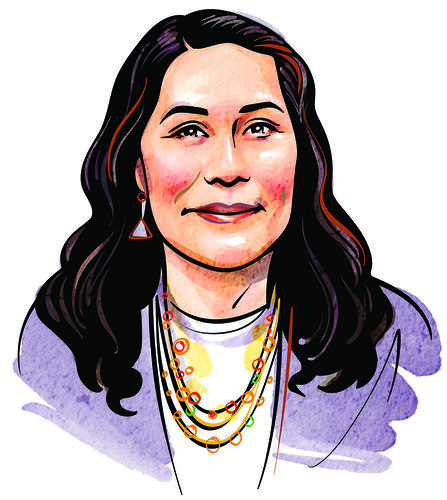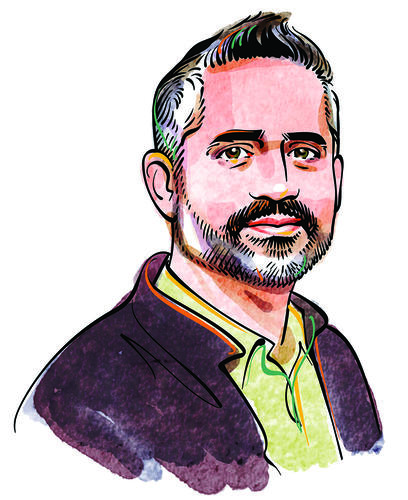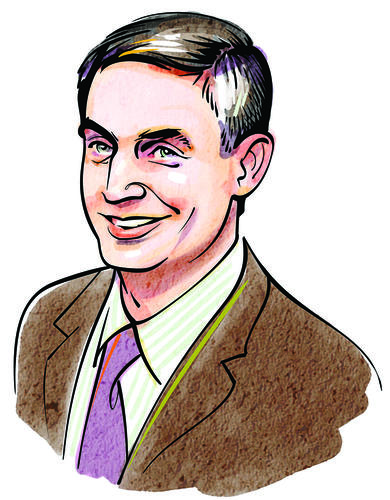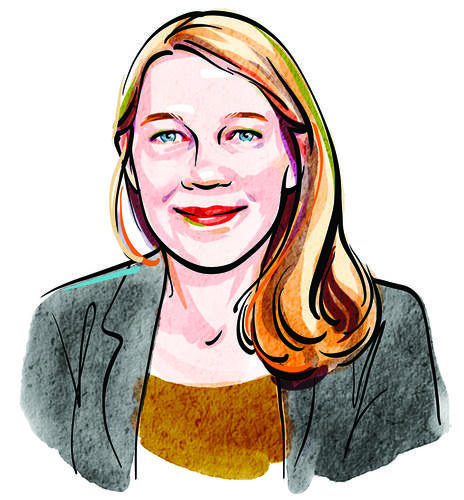
Growing Green
Influenced by their time at Princeton, these eight alumni are working to address climate change
A Journalist Aims to Cover the Environment in ‘the Most Powerful and Evocative Way’
Juliet Eilperin ’92
Deputy Climate and Environment Editor, The Washington Post
When Juliet Eilperin ’92 was in fourth grade, the mishandling of the Iran hostage crisis that began in 1979 led the born-and-bred Washingtonian to stage an election at school. The candidates for secretary of state? Her cat, Jake, who was pitted against her friend Natasha’s dog.“I grew up focused on questions of how people in power were making decisions that were affecting people’s lives,” she explains, “and had lots of opinions.”
These days, Eilperin continues asking these questions as the deputy climate and environment editor at The Washington Post, where she has spent 25 years covering national affairs, the White House, and the environment. On the recently expanded climate desk, she works alongside Zachary Goldfarb ’05 and Shannon Osaka ’17 — “We joke about this,” she says, referencing the Princeton connection — to insightfully report on the warming globe. One such story took her to Alaska’s Tongass National Forest in 2021, where she spoke with fishermen, Indigenous activists, and sawmillers about the fate of a single 500-year-old Sitka spruce.
“What amazes me is how a simple pad of paper and a pen give me access to all sorts of extraordinary stories and places and people,” she says. “By truly engaging with those people, you can reveal something that’s meaningful and that accurately reflects the reality of our world.”
Though Eilperin’s journalism career began during her time editing The Daily Princetonian, her foray into climate issues began when she returned to Princeton as a Ferris journalism professor in 2005, during which she was writing a book on Congress titled Fight Club Politics (2006). Her nascent environmental interest led her to write on sharks and their conservation for her second book, Demon Fish (2011), for which she spoke to “everyone from shark callers in Papua New Guinea to fishermen in Mexico to shark fin traders in Hong Kong.”
Eilperin says she believes when climate change becomes a proxy for political disagreement — the intersection of her coverage areas — that it is important for journalists to write about the reality of the environment “in the most powerful and evocative way possible and allow our readers to decide what to think about it.”
“While it is an important duty of journalists to write about everything that is going wrong in the world,” she adds, “there are times that you should also shed light on things that can provide people with some degree of hope.” J.K.
A Storyteller Tries to Inspire Action and Sacrifice
Jonathan Safran Foer ’99
Author
Between knowing and believing lies a world of difference. The vast majority of Americans know that climate change is a problem; bestselling author Jonathan Safran Foer ’99 writes stories to help them believe it.“The challenge is no longer to simply inform, or even persuade, on the level of science and reason,” says Safran Foer. “The challenge is to inspire action, and oftentimes to inspire some amount of sacrifice.”
Safran Foer is best known as a writer of fiction. His 2002 novel Everything Is Illuminated — which began as his Princeton creative writing thesis — was adapted into a movie starring Elijah Wood, and his 2005 novel Extremely Loud & Incredibly Close became a film starring Sandra Bullock and Tom Hanks. But over the past 15 years, Safran Foer has written two nonfiction books that explore the environmental implications of eating meat.
“Any honest exploration of climate change is going to have to address food,” says Safran Foer. “Changing what we eat will not itself save the planet. But it will be impossible to meet the goals of the Paris Climate Accords if we don’t quite dramatically change what we eat.”
His 2009 book Eating Animals — which he says he wrote, in part, to decide whether to raise his son vegetarian (he ultimately did) — explores the role of storytelling in determining and justifying what we eat. His second nonfiction book, We Are the Weather: Saving the Planet Begins at Breakfast (2019), focuses more squarely on the environmental implications of food.
“Diet is almost certainly the most important change you can make as an individual vis-à-vis the climate,” says Safran Foer. “What to eat is a choice that we make multiple times every day. And for most readers of this interview, it’s a largely unconstrained choice.”
But while Safran Foer believes that the moral case for vegetarianism is clear, he also writes about the challenges involved in changing behavior.
“I wanted to write a book about climate change, about my own experience of feeling lost inside of the problem,” he says of We Are the Weather. “Of caring and not knowing how to care, or knowing how to care and not knowing how to follow through.”
Safran Foer — who credits a conversation with novelist and then-Princeton professor Joyce Carol Oates with jumpstarting his writing career — says he believes that literature holds the power to inspire action on the climate crisis.
“What we’re now facing requires a leap of compassion, of empathy,” says Safran Foer. “We have to find a way to care about future generations, and the of millions of people who are already personally affected. And that is where I think storytelling can play a really important role.” B.W.
A Diplomat Fights to Keep Her Island Country Above Water
Tina Stege ’97
Climate Envoy, Marshall Islands
By the time Tina Stege ’97 arrived at Princeton, she had spent half a decade living away from home. Born in Saipan, the largest of the Northern Mariana Islands, Stege moved to the Marshall Islands, which she has represented as the inaugural climate envoy since 2018.“It was a really big deal to come from a place like the Marshall Islands and end up going to a place like Princeton,” says Stege, who attended high school in Honolulu. For years she lived out of two suitcases, her heart and mind, if not her body, traveling back and forth over the Pacific Ocean as she adjusted to life on the East Coast.
Majoring in public policy, Stege would write her senior thesis on the legacy of nuclear testing on the Marshall Islands. “All these choices and experiences pointed me to the fact that I really needed to go home,” she says.
Ever since, she has spent time working with her country’s Foreign Affairs Ministry across New York, Washington, D.C., and the Marshall Islands, where her family still lives, and where the ocean bubbles up through the floors of her brother’s house when the tide is high.
Home to 60,000 people, the low-lying Marshall Islands sit on the fraught front lines of climate risk: If sea levels rise by a meter, which the United Nations’ Intergovernmental Panel on Climate Change warns may be the case by the end of the century, close to 40% of the islands’ capital city will end up underwater.
But the existential risk is more immediate, Stege explains. When flooding occurs, vegetation dies and rots. Well water becomes brackish, so people can no longer use it for cooking. To prevent these catastrophes, Stege was one of several Marshallese representatives who, during the 2021 COP26 negotiations in Glasgow, pushed developed nations to double their financial contributions towards climate adaptation in developing nations — and succeeded.
“It was a little bit like being home because I was with other Marshallese and we were all working together,” she says, describing Marshallese culture as “super relational.” “It’s so focused on other people and your connection to them. ... I carry that with me.”
Stege, speaking from her home in New York, wore a pink wut, or flower, tucked behind her right ear — a home custom that “makes life brighter and more beautiful,” she explains. It keeps her tethered to the Marshall Islands even when she is far away. “For myself, my children, my family in the Marshalls,” she shares, “my vision is that we’re empowered and can make choices — that we’re empowered to build better futures.” J.K.
An Advocate Works for Indigenous Communities Who Are the ‘Direct Measure of Climate Change’
A-dae Romero-Briones ’03
Director of Programs, First Nations Development Institute
A-dae Romero-Briones ’03 recalls being “blown away” when a Princeton tour guide venerated how old the campus buildings were.“In my own community, we have places that are much older than that and they’re destroyed for water, for lakes, to build dams and pipelines,” says Romero-Briones, whose family heritage lies with the Cochiti and Kiowa people. “I couldn’t figure out why Princeton as a community could use arguments about how important something was because of its age, but these couldn’t be applied to Indigenous communities and Indigenous places.”
Romero-Briones was born and raised by her grandparents in Cochiti Pueblo, an Indian reservation in New Mexico where the Cochiti have considered themselves “part of that landscape since time immemorial.” These days she lives in California, where she runs an agricultural program through the First Nations Development Institute and helps Indigenous communities acquire capital for land stewardship projects through the Manzanita Capital Collective.
She does this work in the belief that “Indigenous people are the direct measure and the visualization of climate change,” she says. The creation of dams for industrial agriculture altered natural waterways in Indigenous territories, and the clearing of “entire swaths of forests” led to the removal of carbon sequestering trees — harming the health of Indigenous populations in addition to the Earth.
Romero-Briones’ principal focal point has been food, which she considers “the center of how Indigenous people express community and connections with each other and the land.” After getting her Princeton degree in public policy, Romero-Briones pursued a food and agricultural law degree at the University of Arkansas, where she explored the Food Safety Modernization Act and how it curtailed the freedom of native food practices.
By supporting Indigenous projects in traditional modes of growing food, including the cultivation of wild rice and traditional corn varieties, Romero-Briones seeks to promote healthful food practices that are less burdensome on the planet’s resources and improve the health of Native people.
“We come after water, we come after land, we come after the animals, we come after plants ... and we as the youngest relations on this planet have a duty to learn from everybody older than us,” Romero-Briones says. “I’m just one person in a long line of Indigenous people who have continued to fight for our story and our view of the world, because it not only protects Indigenous people, it protects everybody when we have a healthy world.” J.K.
An Environmental Leader Takes the Sierra Club in a New Direction
Ramón Cruz *02
President, Sierra Club
What comes to mind when you think of the Sierra Club? Probably Yellowstone, Yosemite, the Grand Canyon. Middle- and upper-class white folks rallying to preserve pristine rivers, forests, and mountains. But in recent years, and especially under the leadership of Ramón Cruz *02, the Sierra Club — today the largest grassroots environmental organization in the United States — has shifted its main focus from wilderness conservation to global climate change.“Climate change is at the core of everything we do,” says Cruz, the organization’s 51st president. “The climate crisis is not only about preserving biodiversity and landscapes. It’s also about ensuring that future generations can have a good standard of living, and that their future and their natural environment is not being jeopardized.”
The first Latino president in the Sierra Club’s 130-year history, Cruz — who hails from Puerto Rico — has broadened the organization’s mission to include issues that have not historically been associated with the environmental movement: reproductive rights, voting rights, and anti-racism.
“The same people whose votes are being suppressed are the same people who are most affected by the climate crisis, and who have suffered a history of pollution,” said Cruz. “We can no longer think of these issues in silos.”
Under Cruz’s leadership, the Sierra Club has taken pains to publicly reckon with its own past. In 2020, the organization publicly denounced founder John Muir’s association with white supremacists and eugenicists, including club members Joseph LeConte and David Starr Jordan. Cruz has also criticized the organization’s early advocacy for the creation of national parks on lands populated by Native Americans.
“In the past, the Sierra Club was not necessarily conscious of the size and relative power we had when parachuting into environmental issues,” says Cruz. “Some of those pristine places that were preserved used to be very well managed by Indigenous people.”
Before joining the Sierra Club, Cruz worked for the Environmental Defense Fund, the Institute for Transportation and Development Policy, and the Environmental Quality Board of Puerto Rico. He attributes his career path in part to graduating from Princeton’s MPA program debt-free.
“The school’s focus on public service, along with spending zero on my graduate education, allowed me to pursue a career in environmental policy,” says Cruz, who received a Public Policy and International Affairs fellowship to attend Princeton. “I didn’t have the hefty student debt that other people may have — and that, for me, was crucial.” B.W.
An Environmental Economist Tries to ‘Improve Our Understanding of the World’
Michael Greenstone *98
Economics professor, University of Chicago
Before becoming one of the most prominent thinkers in the field of environmental economics, Michael Greenstone *98 dreamed of playing in the NBA.“That was my first choice by far,” he jokes. “I just wasn’t good enough.”
But one diverted path led to plenty of others. Now an economics professor at the University of Chicago, Greenstone — who received his Ph.D. from Princeton after studying economics at Swarthmore College — has advised President Barack Obama’s Council of Economic Advisers, where he introduced the concept of applying a dollar value to harms caused by carbon emissions; co-founded Climate Vault, a nonprofit platform that purchases and “vaults” carbon dioxide emissions permits so that the corresponding CO2 cannot be emitted into the atmosphere; and co-directs the Climate Impact Lab, which quantifies the impacts of climate change around the world.
“The planet doesn’t care very much if you compost your coffee grounds, but it does care a lot about tons of CO2,” says Greenstone of the empirical basis of his initiatives. In pursuing them, Greenstone seeks to combine his academic father’s “search for understanding the world” with his mother’s inclination as a social worker to “to make the world a better place,” he explains.
Greenstone arrived in Princeton to study labor economics under the tutelage of Orley Ashenfelter and David Card *83. But while searching for a compelling avenue for research, he “accidentally got interested” in environmental questions that no one was answering, such as how the Clean Air Act affected air quality in America, the eventual subject of Greenstone’s thesis.
Beyond the United States, Greenstone has conducted research in India and China, where he investigates the intersections of economics, pollution, and public health. After a decade of assisting the government of Gujarat, a state in western India, to design a cap-and-trade program that would reduce air pollution and industrial costs, his team is now receiving inquiries from other Indian states to create similar systems.
“I do think a conceit of rich countries is that climate is the only thing that matters and it’s just not true, you know, around the world,” he says, putting forward his belief in three climate goals: ensuring access to inexpensive and reliable energy, maximizing local environmental quality, and avoiding disruptive climate change.
“One thing I work hard on is to write papers that improve our understanding of the world,” he says, “and then I try to make sure that those ideas get inserted into the bloodstream.” J.K.
A Strategist Seeks Economic Growth Through Sustainability
Joseph Majkut *14
Director of Energy Security and Climate Change Program, Center for Strategic & International Studies
“How do we have a productive economy that will satisfy global needs for economic growth without greenhouse gas emissions?”It’s the trillion-dollar question, and it guides Joseph Majkut *14’s work as director of the Energy Security and Climate Change Program at the Center for Strategic and International Studies (CSIS). The question breaks down into innumerable smaller ones.
“What’s the right stance for the U.S. to take on climate finance? How do we effectively export the success of the Inflation Reduction Act? How do we make sure that we’re pursuing global solutions?”
Majkut seeks to understand the scientific, economic, and geopolitical dimensions of the renewable energy transition, and to provide insights that policymakers can act on. For example, after Russia invaded Ukraine in 2022, threatening European energy security and causing a spike in gas prices, Majkut and his team at CSIS published a list of seven policy proposals to respond to the energy crisis. Most of these proposals — which generally advocated for time-limited increases in natural gas production paired with policies to increase clean energy development — were soon adopted.
“There was concern that if the U.S. built gas infrastructure and sent a lot of gas to Europe, that it wouldn’t square with the long-term climate goals that both Europe and the world hold,” says Majkut. “We argued that the U.S. had a really vital role to play in guaranteeing energy security, but that this didn’t need to come at the sacrifice of climate outcomes.”
Majkut developed his interdisciplinary toolkit at Princeton, where he completed a Ph.D. in atmospheric and oceanic sciences, taking additional courses at the High Meadows Environmental Institute and the School of Public and International Affairs.
“Princeton provided a really great foundation in understanding the science of climate change, allowing me to think through how that science applied to the decisions that society faces when trying to respond to climate risks,” he says.
Since graduating, Majkut has served as a congressional science fellow for Sen. Sheldon Whitehouse, D-R.I., testified before Congress, and directed climate policy at the Niskanen Center. Now, in the wake of the Inflation Reduction Act — a landmark 2022 bill that offered subsidies and spending programs to jumpstart America’s transition to low-carbon energy — Majkut is largely focused on realizing the act’s potential.
“Building a low-carbon energy system is a big infrastructure problem,” he says. “If we can’t build stuff fast enough, we’re not going to be able to decarbonize as quickly as we otherwise could. And that, I think, is the next public policy challenge for the United States.” B.W.
An Epidemiologist Readies for Climate Change’s Impact on Infectious Diseases
Rachel Baker *18
Epidemiologist and Assistant Professor, Brown University
The World Health Organization has called climate change the “single biggest health threat facing humanity” — and a significant part of this threat is the spread of infectious diseases. But according to Rachel Baker *18, an epidemiologist and assistant professor at Brown University, the effect of climate on disease transmission remains a scientific lacuna.“For many infectious diseases, we see some sort of climate signature in the timing and geographic patterns of outbreaks,” says Baker, whose work has been featured in The New York Times, The Atlantic, and Scientific American. “But this is a nascent field, and there’s a lot more work to be done in terms of projecting what those future patterns of outbreaks might be and how quickly we might see those shifts occur.”
To date, most research in this area has focused on vector-borne diseases — those spread by mosquitos, ticks, and other organisms. (While the dynamics involved are complex, available information indicates that such illnesses will become more prevalent in a warmer world.) Relatively little is known about how climate affects respiratory diseases — and it is on this issue that Baker has set her sights.
“We’re trying to understand the extent to which environmental and climate factors determine seasonal patterns of respiratory disease outbreaks,” says Baker. “Why is the flu season in the winter? Why do we see outbreaks of enteroviruses in the summer? Then we’re trying to use that understanding in combination with climate change projection data to figure out how climate change might shift those patterns.”
Baker began exploring these questions at Princeton, where she completed her Ph.D. at the School of Public and International Affairs, and then worked as a postdoctoral researcher for the Princeton Climate Change and Infectious Disease Initiative — an interdisciplinary research team led by biologist and demographer C. Jessica Metcalf, geoscientist Gabriel Vecchi, and biologist Bryan Grenfell.
“We need interdisciplinary teams to work together on this problem,” says Baker. “This is why the Princeton Climate Change and Infectious Disease Initiative was so foundational for me and such a great experience. Finding those sorts of teams that actually work together is rare.”
Baker’s research thus far suggests that climate change may drive tropical outbreak patterns north and south of the equator, resulting in year-round transmission with milder spikes. But she stresses that this area requires further research.
“We’re not going to be prepared for something that we don’t know about,” says Baker. “And that’s what I’m worried about with climate change and infectious diseases. There are a lot of parts out there that we just don’t know.” B.W.
Jimin Kang ’21 is a freelance writer and Sachs scholar pursuing a master’s in Nature, Society & Environmental Governance at the University of Oxford. Ben Weissenbach ’20 is an environmental writer and was recently named a 2023 Gates Cambridge scholar.













1 Response
Scott Scharfman ’86
2 Years AgoExpertise in Climate Modeling
I was surprised to read, in “The Climate Issue,” articles about various climate policy and humanities activities of Princetonians, but nothing at all about Princeton’s role in climate science. Alumni should know that Princeton is also a leader there. For example, under the leadership of Ning Lin *10, an associate professor of civil and environmental engineering, Princeton developed world-leading AI technology used to model hurricanes under a changing climate. Called the Princeton environment-dependent probabilistic tropical cyclone (PePC) model, it projects the serious hazards of high-speed winds, storm surge flooding, and extreme rainfall from future hurricanes. Jupiter Intelligence, a company that helps governments and businesses assess their climate risk, integrates PePC into their larger risk models. The CEO of Jupiter is a Yalie, so you can be sure they only use Princeton’s model because it’s the best in the world.